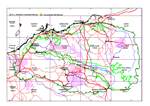Click on images
to enlarge



Photographer: B.R. Maslin

Photographer: B.R. Maslin

Photographer: B.R. Maslin
, H Denary D7228, lab photo by Fiona McCallum ADJUSTED_sml.jpg)
Seed from one herbarium voucher. Scale in mm. Photographer: F. McCallum.
Botanical name
Acacia walkeri Maslin, Nuytsia 18: 184, fig. 12 (2008)
Common name
Walker's Wattle
Description
Spindly and sometimes straggly, erect, glabrous shrubs (1-) 2-2.5 (-3.5) m high, with 1 or 2 slender stems from ground level, stems 4-5.5 cm diameter near base, typically openly branched with sparse foliage but sometimes bushy, phyllodes occasionally crowded at ends of branches. Bark light grey, smooth. Branchlets light brown to red, resinous, often viscid, lenticellate, scarred where phyllodes have fallen. Stipules persistent, triangular, minute (0.5-1 mm long), erect, brown, often enveloped by resin. Phyllodes acicular, linear, quadrangular-terete to flat, (8-) 10-20 (-30) mm long, 0.5-1.2 mm wide, with l:w=30, rigid, patent to slightly inclined, straight, normally sub-glaucous to ±glaucous, infrequently pale green, not pruinose, 4-nerved (one on each face and one on each margin when flat), midrib< /A> ±prominent and raised on flat phyllodes when dry; gradually narrowed at apices into a very sharp, rigid, straight, brown cusp c. 1 mm long. Inflorescences simple, single or 2 within axil of phyllodes; peduncles straight, slender, spreading, rarely exceeding the phyllodes, yellow (often light brown when dry), 10-15 (-20) mm long, basal peduncular bracts absent; heads showy, globular, 5-6 mm in diameter when fresh, light golden to mid-golden, with 40-60 flowers. Flowers 5-merous; sepals free, linear-spathulate, c. ¾ length of petals; petals 1.6 mm long. Pods sub-moniliform, rounded over seeds and constricted between them, (2-) 3-5 cm long and 3 mm wide, firmly chartaceous to thinly coriaceous, straight or almost so, reticulately nerved but nerves not or scarcely evident, light brown. Seeds longitudinal in the pods, obloid to obloid-ellipsoid, 3-3.5 mm long, 2-2.5 mm wide, dull, dark brown to blackish and mottled cream, with cream-coloured tissue bordering the pleurogram and bordering the periphery of the seed; funicle thread-like and not expanded into an aril.
Characteristic features
Erect, spindly, glabrous shrubs with 1 or 2 slender stems from ground level. Branchlets light brown to red, resinous, often viscid, lenticellate. Stipules persistent, minute (0.5-1 mm long), erect, often embedded in resin. Phyllodes acicular, normally 10-20 mm long, very narrow (0.5-1.2 mm wide), rigid, straight, normally sub-glaucous to ±glaucous, infrequently pale green, quadrangular-terete to flat, 4-nerved, midrib ±prominent when phyllodes flat; apices gradually narrowed to a very sharp, straight cusp. Inflorescences simple; peduncles straight, slender, spreading, rarely exceeding the phyllodes, yellow (often light brown when dry), 10-15 (-20) mm long; heads globular, 5-6 mm in diameter when fresh. Sepals free, linear-spathulate. Pods sub-moniliform, narrow (3 mm), thin-textured. Seeds dark brown to blackish and mottled cream; funicle thread-like and not expanded into an aril.
Distribution and ecology
Confined to the Western Australian arid zone where it extends from the western edge of the Little Sandy Desert and Pilbara regions eastwards through the northern Great Victoria Desert and southern Gibson Desert to the Central Ranges near the border of Northern Territory and South Australia. Acacia walkeri is rare in the Pilbara where it is known from just a single, large population about 90 km east of Newman. It grows on red sand plains and rocky slopes in gravel and lateritic soils (sandy loam or clayey sand), with other shrubs over open spinifex.
Flowering and fruiting period
Flowering has been recorded from June to October with peak flowering in August and September. Pods with mature seeds have been collected in October and November.
Taxonomy
This species was noted as a narrow phyllode variant of A. maitlandii by Maslin (1981 and 2001) and until recently was known by its phrase name Acacia sp. Gunbarrel (B.R. Maslin 5665).
Affinities
Acacia walkeri is closely related to A. maitlandii and the two species sometimes grow together in the Pilbara but no hybrids between them have been observed. Acacia maitlandii can be distinguished from A. walkeri in having broader phyllodes, (1.5-) 2-4 (-5) mm wide, which are differently shaped (±asymmetrically narrowly elliptic to oblong-elliptic or oblong-obovate) and consistently flat and green, larger flower heads (about 9 mm in diameter when fresh) and normally broader pods that measure (3-) 4-5 (-10) mm wide. Future studies may show that A. walkeri would be better treated as a subspecies of A. maitlandii. This species could possibly sometimes be confused with A. tetragonophylla. In A. tetragonophylla the phyllodes are clustered in groups of 2-6 on mature branchlets but on new shoots they occur singly as they do in A. walkeri. Therefore, in cases where only new shoots of A. tetragonophylla are present that species can be distinguished from A. walkeri by having phyllodes with a total of five longitudinal nerves (four in A. walkeri), caducous stipules and non-lenticellular branchlets; A. tetragonophylla also has much larger, curved to coiled pods with the seeds encircled by a bright orange-red or yellow aril.
Conservation status
Not considered rare or endangered.
Origin of name
This species is named for Ken Walker who has collected many plants (over 600) from the Pilbara during the past 30 years. Ken made the first ever collection of A. subcontorta and has undertaken many specific collections of Pilbara acacias on our behalf. He was a founding contributor to the (now disbanded) Pilbara Regional Herbarium and has been instrumental in improving standards of landform and vegetation rehabilitation, and weed control on mine sites, throughout the region.
References
Maslin, B.R. (1981). Acacia. pp. 115-142. In: J. Jessop (ed.) Flora of Central Australia. pp. 537. (A.H. and A.W. Reed: Sydney.)
Maslin, B.R. (2001). Acacia. In: A.E. Orchard and A.J.G. Wilson (eds) Flora of Australia. Volume 11A. pp. 536. (ABRS/CSIRO Publishing: Australia.)
